
Mother-daughter weekend in Barcelona
Early November it was time for our annual mother-daughter weekend again. After Paris two years ago and Copenhagen last year, this time it would be a weekend in Barcelona. Mum had never been, and I had only visited Barcelona once briefly for work but had not really seen much of the city. The fact that Barcelona still had some half decent weather in early November certainly didn’t hurt either. I mean who would say no to 20 degrees and sunshine when the weather at home is rainy and cold. Let me tell you what we’ve been up to during our weekend in Barcelona. We might not have seen all there is to see in Barcelona, but this first-time itinerary for Barcelona sure did the trick (for us).
Without further ado, let’s get started.
Weekend in Barcelona: Friday
As with all our mother-daughter weekends, we would meet there rather than travel together. Meaning I would fly from London, mum from Frankfurt. We usually aim to pick flight times that will get us to our destination at a similar time. For Barcelona mum was due to arrive just 15 minutes before me. Giving me a chance to catch up with her by the exit (given her slightly slower speed and lesser experience navigating airports).
In the end, my flight was delayed by a good hour. But since mum’s was also 40 minutes late, she still didn’t have to wait too long for me.
And we managed to find each other without much trouble.
I had used my extra wait time at London Heathrow to prebook our Hola Barcelona cards (the travel card for Barcelona). Since we were staying until Monday afternoon, I opted for 96-hour tickets. In hindsight, it would have probably been cheaper to buy 2 single tickets to get to our hotel, then buy a 72-hour ticket the next morning. But it just seemed easier this way.
Once we had collected and validated our tickets at the station, we took the Metro towards our hotel.
When visiting any city for the first time, picking the right location for the hotel always seems to be the hardest thing. Mr T and I got it very wrong a few years back when visiting San Francisco. But for our weekend in Barcelona, I checked with friends to pick a suitable location. And ended up with a hotel just off La Rambla. Which might be a little touristy but worked well for us.
Mercat de Sant Josep de la Boqueria
By the time we made it to the hotel, checked in and were ready to start exploring Barcelona, it was almost 4pm. Therefore, our first priority was the hunt for a late lunch.
Luckily, the Mercat de Sant Josep de la Boqueria (or short: Boqueria Market) was just a few steps from our hotel. Although some vendors were already starting to close, most of the food stalls were still open. So, we grabbed ourselves some empanadas and olives for a quick on the go lunch.
Boqueria Market is one of Barcelona’s oldest produce markets. From its first beginnings as a meat market in the 13th century, it has changed in size and name several times over the years.
Nowadays, you will find plenty of ready to eat food at Boqueria, perfect if you’d like to pick up a quick lunch. But you can also buy fresh meat and fish as well as fruit and vegetables.
La Rambla and Palau Güell
With our stomachs no longer rumbling, we could finally start exploring Barcelona. After all, this is what our weekend in Barcelona was all about.
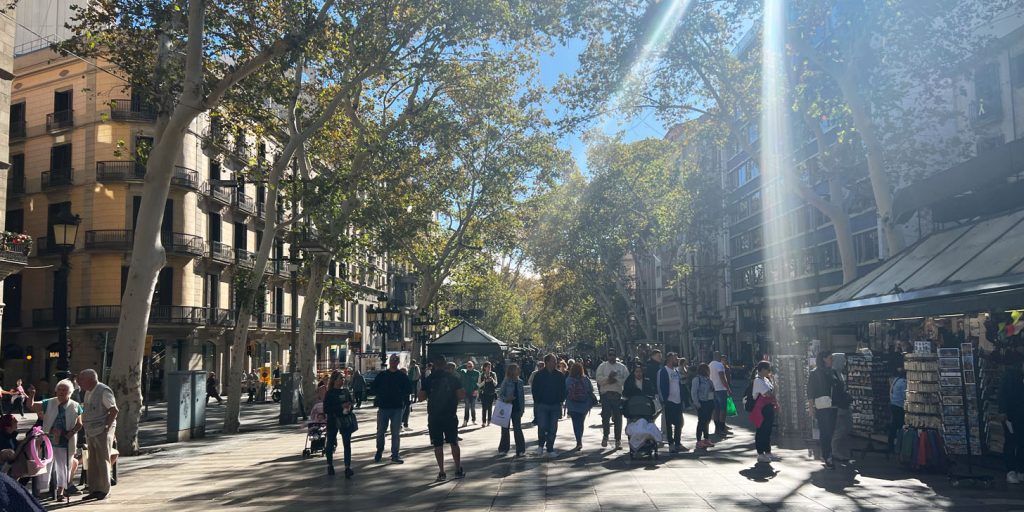
As we had not really made any plans for our first day, we just played it by ear.
From Boqueria Market, we started walking down La Rambla.
Probably one of the best-known streets in Barcelona, this wide, tree-lined avenue stretches from Place Catalunya to Port Vell, approx. 1.3 km in total.
We had already walked the top bit on our way to the hotel (as we came out of the Metro at Place Catalunya). But this time, we were heading towards Port Vell. Just a few steps and we came across the Gran Teatre del Liceu (Great Theatre of the Lyceum), Barcelona’s opera house. Unfortunately, I completely missed its proximity to the hotel when I prepared for our mother-daughter weekend in Barcelona. Otherwise, I might have checked what they were showing that weekend. After all, mum and I both love to visit opera houses and have done so on mother-daughter weekends in Vienna and Copenhagen. And Paris’s Opera Garnier is still very high up our wish list (despite two mother-daughter trips to Paris, we have somehow never managed).
We continued on La Rambla a little longer, before heading to the Palau Güell.
Palau Güell is one of seven Gaudi sites in Barcelona, that all together form the Unesco World Heritage Site ‘Works of Antoni Gaudí’.
The mansion was built in the 1880s and features a dark, slightly moody fa?ade with intricate ironwork on the windows and the entrances arches.
Palau Güell is open to the public and tickets can be bought for 12 EUR / adult. Unfortunately, standing in front of the building, we did not really get to see the multicoloured chimney pots on its roof. For those we would have needed to buy a ticket and go up to the roof terrace.
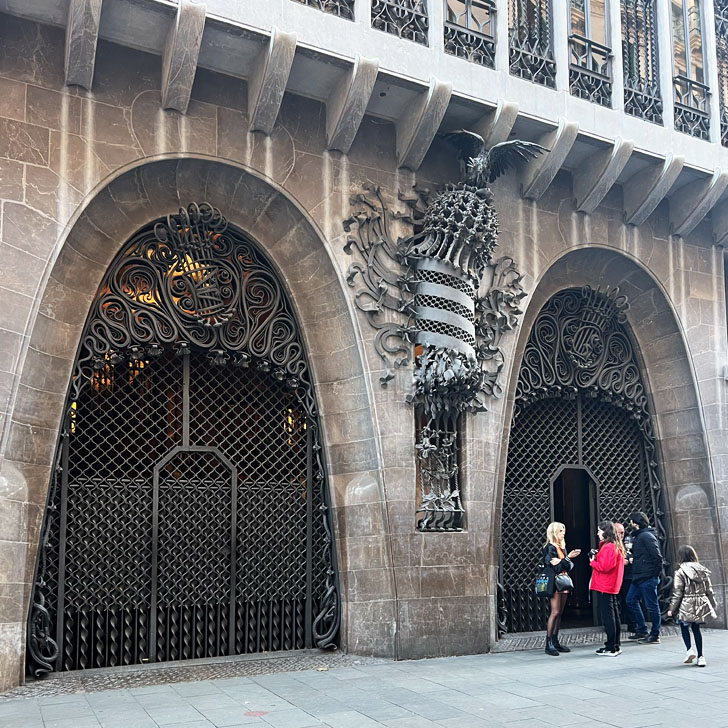
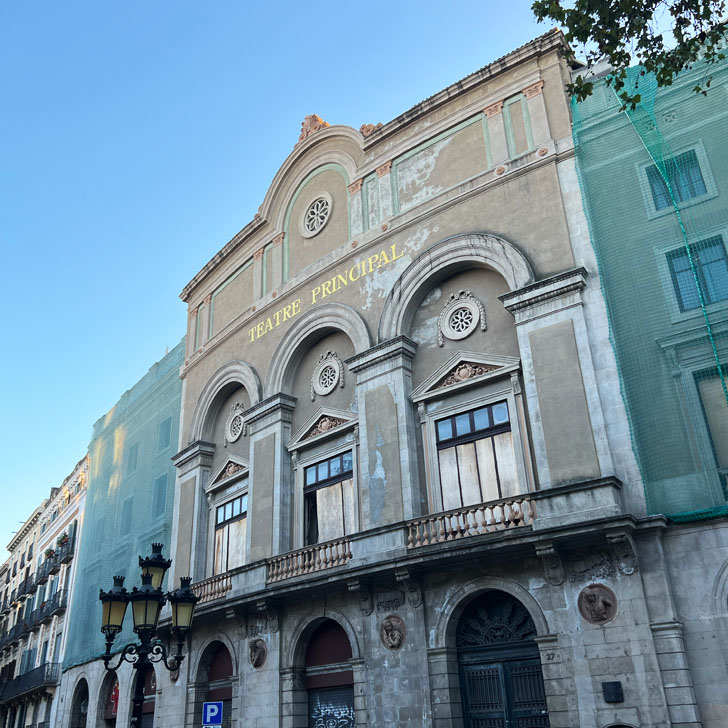
So, after a few snaps, we continued our Barcelona walking tour. Back onto La Rambla and it wasn’t long until we came past the next Barcelona sight. The (now disused) Teatre Principal, Barcelona’s oldest theatre, dating back to the 16thcentury.
As we got to the end of La Rambla, we continued our walk along the waterfront.

Gothic Quarter
When we left the hotel earlier, the sun was shining, and it was pleasantly warm. Unfortunately, by the time we made it down to the water, it had become rather windy, and the sun was slowly starting to set. So, we didn’t spend too long down by the water. Instead, we headed towards the narrow winding streets of Barri Gòtic, the Gothic Quarter.
The Gothic Quarter is Barcelona’s historic town centre, housing some of Barcelona’s oldest buildings and the remnants of a Roman village. As the blue hour was upon us, walking this maze of cobbled street was quite something. The narrow streets are mainly closed for traffic (deliveries excluded obviously). Which thankfully reduced the chance of being run over. As we kept stopping frequently to look at facades and take a myriad of photos.
We eventually arrived at the Barcelona Cathedral. The 13th century Gothic church was standing proud against the darkening sky, looking very majestic. Unfortunately, there was no entry that evening, as there was some kind of event going on. And somehow, we didn’t really manage to go back to the cathedral during the rest of our weekend in Barcelona. Which was actually a shame, as you apparently get an amazing view across Barcelona from the roof top. Oh well, next time. Gives me a reason to go back to Barcelona for another visit.
Instead, we had a look around the Mercat Gòtic (Gothic Market). An antiques market on Pla?a Nova, conveniently located in front of the cathedral.
To conclude the first evening of our weekend in Barcelona, we went for tapas and sangria at a small bar near Palau Güell.
Saturday
After breakfast at the hotel, it was time to start day two of our weekend in Barcelona. We didn’t completely plan our first-time itinerary for Barcelona minute by minute. But we prebooked tickets to go to the Park Güell that afternoon. So, it made sense to us to head roughly in that direction right from the start.
Gracia
Our first stop that morning was the Gracia neighbourhood. Originally its own little town, the historic quarter of Gracia nowadays is part of Barcelona. We spent some time walking the side roads, looking at all the charming facades. Before stopping briefly at the Mercat de la Llibertat (the Freedom Market), another one of Barcelona’s fresh produce markets. Open since 1888, Mercat de la Llibertat is open Monday to Saturday and offers a selection of different foods and fresh produce. Since breakfast wasn’t that long ago, we only had a look around, but didn’t buy anything.
Instead, we continued our stroll through the neighbourhood, until we arrived at Casa Vicens. Another building belonging to the Unesco World Heritage Site ‘Works of Antoni Gaudí’.
Built at the end of the 19th century, Casa Vicens is considered Gaudi’s first major development. Originally a residential building, Casa Vicens is now a modernist museum. Although it is opened daily, we did not actually go into the museum, just looked at the building from the outside.
Park Güell
Eventually it was time to head to Gaudi’s Park Güell. We had prebooked tickets for Park Güell ahead of our first-time weekend in Barcelona. At 10 EUR for adults (and 7 EUR for over 65s), this is the cheapest of the Gaudi’s works in Barcelona.
To get to Park Güell, you can either take the Metro to Lesseps or take a bus. However, most routes will require a bit of walk. It is just over 1km from Lesseps Metro station to the entrance of Park Güell, most of it uphill. So, definitely allow some extra time to actually get to the park.
Park Güell was built at the beginning on the 20th century and opened in 1926. Originally, the park was meant to be part of a bigger housing development, similar to the English garden village concepts. But in the end, only the park and two houses were built before the project was abandoned.
The fully landscaped park is a mixed of Art Nouveau architecture and designs: Mosaic sculptures, benches, houses, and serpentine stairs. Pair this with some amazing views across Barcelona and you are in for a real treat. We spent a good two hours just wandering through the park. Unfortunately, it was busy. Probably to do with it being Saturday afternoon. Especially on the mosaic terrace and near El Drac (the mosaic salamander at the entrance), it was almost impossible to take a proper look, let alone some Instagram worthy images. But that aside, we did enjoy the visit and I would add Park Güell to any first-time itinerary for Barcelona.
Las Arenas
After our visit to the park, we decided to head to Las Arenas.
The old bullring (originally called Plaza de Toros de las Arenas) first opened in 1900 and hosted bullfights up until 1977. After years of closure, it eventually reopened as the shopping mall ‘Arenas de Barcelona’ in 2011. Responsible for this refurbishment were the Spanish architects ABAA, along with Richard Rogers (probably better known for the Centre Pompidou in Paris and the Lloyds Building in London).
We spent a little time mooching around the shops, but our main reason for visiting the shopping mall was the 360-viewing platform at the top. Access to the platform itself is free of charge, but if you would like to use the external glass elevator to get there, it will cost you 1 Euro. Alternatively, just use the escalator inside the shopping mall completely for free.
If you have more time, there is plenty more to see in the area: the Magic Fountain, the historic Botanical Garden, the Parc Joan Miró.
For the evening, we went back to the Gothic Quarter for another dinner of tapas and sangria.
Our weekend in Barcelona: Sunday
The one big thing that was on our first time itinerary for Barcelona right from the start was the Sagrada Familia. And to avoid disappointment, we prebooked our tickets weeks before the trip.
So, after a relaxed breakfast at the hotel, we made our way towards Barcelona’s most famous landmark.
Sagrada Familia
When I first visited Barcelona for work a few years ago, we had a very quick walk up to the Sagrada Familia after dinner. But getting five minutes to look at the cathedral in the pitch black doesn’t do it justice. So, I was very much looking forward to finally visiting and experiencing the cathedral myself.
We had already caught a glimpse of the Sagrada Familia from Park Güell the day before. As it is hard to miss the iconic shape of the cathedral dominating the Barcelona skyline. But that was no comparison to actually standing right in front of it.
The Sagrada Familia is quite different to any other cathedral I’ve seen before (and believe me, I’ve seen my fair share over the years). First up, it obviously isn’t a church steeped in centuries of history. Whilst most cathedrals are hundreds of years old, the Sagrada Familia was only consecrated in 2020. And still is a work in progress. Completion of the basilica is currently estimated to be somewhere around 2030 to 2040. The idea of having it all finished by 2026 to coincide with the centenary of Gaudi’s death was abandoned thanks to further building delays (and a global pandemic).
With our pre-booked tickets, we had an allocated time slot for entry. At first, it was a little confusing to work out where we were supposed to queue, as our ticket didn’t show a gate number. But we worked it out (well, we asked). Before you go up to the Sagrada Familia, you’ll have to go through an airport style security area. It originally said that you weren’t allowed to bring in beverages and we quickly drank one of our water bottles, just in case. But in the end, security had no objection with us carrying water. I guess it might depend on the amount of water and the container. A small water bottle was absolutely fine when we visited.
When booking our Sagrada Familia tickets, we went for church access only and not including tower access. Church only is 26 Euro, if you wanted to go up the Passion Tower or Nativity Tower, it would be an additional 10 Euro. I was a little unsure, whether to add access to my ticket or not, but in the end decided not to.
Yes, the tower would probably give you some amazing view across Barcelona. And getting up there by elevator sounded quick and easy. But the idea of having to walk down the narrow staircase to get back wasn’t something I fancied. Access isn’t recommended for people with limited mobility, so mum was out anyway.
When prebooking tickets for the Sagrada Familia, you will be asked to download their free app. On which you can then access your tickets. The app also includes an audio guide, that will tell you about the cathedral and its construction as you walk around.
Although lacking centuries of history, it is quite something stepping into the Sagrada Familia for the first time. The architecture is unlike any other church I’ve ever been to. I was mesmerized by the amazing light seeping through the coloured windows.
In total, we spent a good hour and a half in and around the cathedral.
Beach
Once we had enough of the Sagrada Familia (well, enough for now, more on that later), we decided to head down towards Barcelona beach.
Even though we were already on day three of our first-time weekend in Barcelona, we had not seen the beach yet. We had a brief glimpse of the sea Friday when wandering down to the harbour, but not been anywhere near since.
We took the bus from the Sagrada Familia towards the seaside for a little walk along the beach. And dipping our toes into the water.
And since we were already at the beach, we decided to also add lunch by the water to our first time Barcelona itinerary. We found a nice restaurant with a covered terrace directly by the beach and shared a vegetable paella. Mum being a pescetarian and me not eating any seafood narrowed the paella options down considerably, but we could agree on the vegetable version.
Sagrada Familia by night
After a little siesta at the hotel, we headed back to the Sagrada Familia again. Not to go in again, but to see it at night-time.
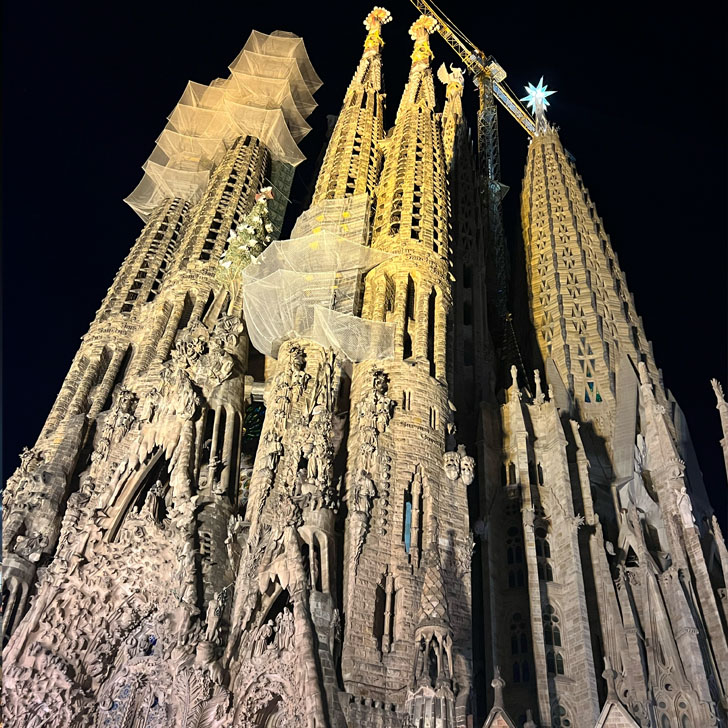
From there, we took a walk back towards the Gothic Quarter for the last evening of our weekend in Barcelona.
We probably underestimated the distance, as we ended up walking for a lot longer than we originally planned. Along our route, we came back La Monumental, a historic bull ring that these days is used as a concert hall and museum. As well as the Arc de Triomph and city hall.
Mother-daughter weekend in Barcelona: Monday
Our flights back weren’t until the early evening, meaning we still had almost a full day in Barcelona ahead of us. After breakfast, we checked out, but left the luggage at the hotel.
We still had a couple of things on our first-time Barcelona itinerary: Gaudi’s Casa Batlló and Casa Mila and probably the Picasso Museum.
Unfortunately, we forgot to check opening hours beforehand, so completely missed the fact that the Picasso Museum was closed on Mondays. Oh well, I guess that is something to add to my itinerary next time I make it to Barcelona.
Casa Milà and Casa Batlló
Even though we didn’t manage to see all seven buildings that form the Unesco World Heritage Site ‘Works of Antoni Gaudí’, we did want to see Casa Mila and Casa Batllo. Not necessarily go in (turns out visiting all Gaudi works, would turn into quite an expensive weekend in Barcelona), but at least see them from the outside.
So we started at Casa Mila, also called La Pedrera (meaning ‘ the stone quarry’).
The impressive corner building was the last private residence Gaudi designed in his life time and it was completed in 1912. It was quite an unusual building at the time. It featured a curvy self-supporting stone fa?ade, an open plan layout and even an underground garage. Quite standard these days, but not so a century ago. Casa Mila also features a big roof terrace, which you can only access with a ticket.
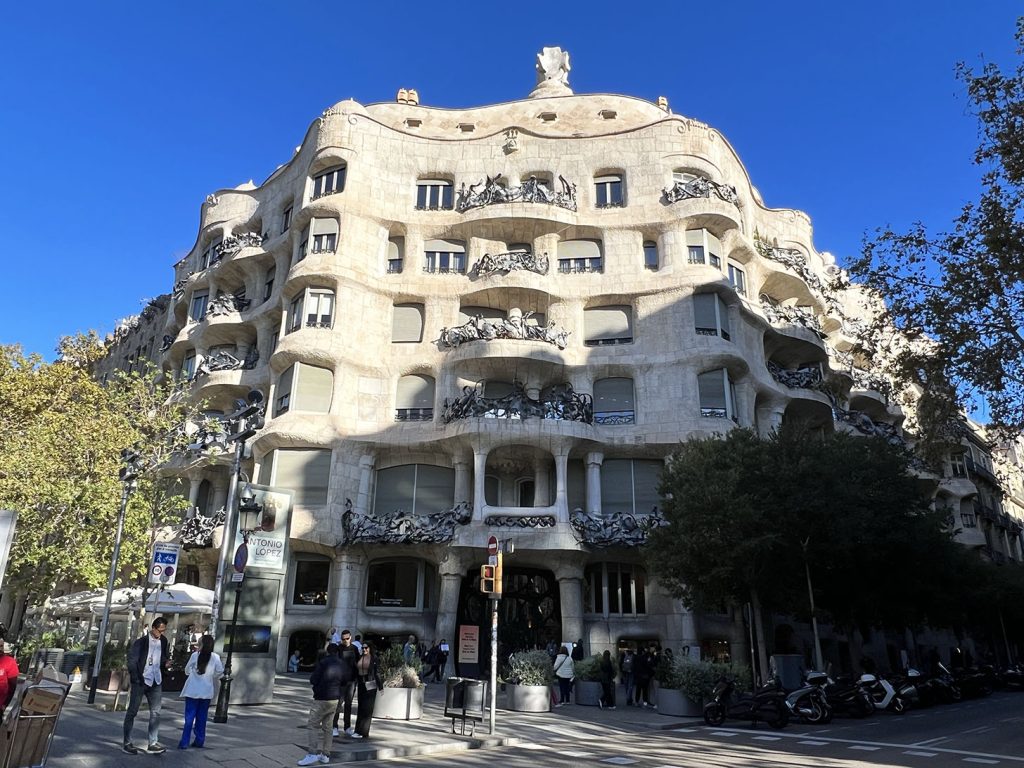
From Casa Mila, we walked the few blocks to Casa Batlló, another one of Gaudi’s residential buildings. Although, to be correct, the building itself was actually built 30 years prior. Gaudi merely refurbished it and made it, what it is today. A building with a very organic looking mosaic fa?ade and a dragon back as a roof.
With six out of seven Gaudi works ticked off our list of things to do during our first-time weekend in Barcelona, we spent the rest of the day just wandering the streets, browsing the shops around Place de Catalunya and buying some last-minute souvenirs.
Eventually it was time to pick up our bags at the hotel and head towards the airport. Our flights were due to leave within an hour from one another. We headed to the airport early enough to have one last coffee together before it was time to board.
As always, we fully enjoyed our mother-daughter weekend in Barcelona. Yes, we probably could have included more things to our first-time itinerary for Barcelona. But these weekends aren’t necessarily about adding as many things to see to our itinerary as humanly possible. Instead, it is about having time together, good food and drink, some sightseeing, some rest. Maybe the lengthy evening walk from the Sagrada Familia to Gothic Quarter aside, I would say, we did strike a good balance. At least I hope so.
Tell me, what should we have added to our first-time itinerary for a weekend in Barcelona? What is your favourite thing to see in Barcelona?


